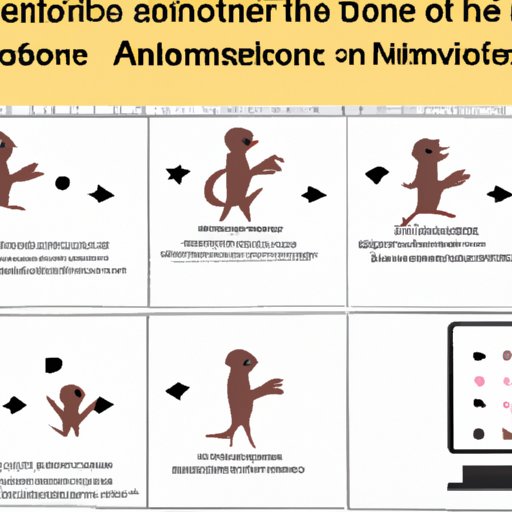Introduction
Animation is the art of bringing characters and stories to life. It is a powerful storytelling tool that has captured audiences for decades. From classic cartoons to modern day blockbusters, animation has the ability to inspire, entertain and influence people of all ages.
In this article, we will guide you through the process of creating your very own animation project. We will begin with the basic tools and techniques you will need, and gradually introduce you to more advanced concepts such as developing a story, creating a storyboard, and bringing your project together for a polished final product. We will also explore the history of animation, tips and tricks from the pros, the role of animation in storytelling, and how it can be used to create social change.
A Step-by-Step Guide for Beginners
Before you can begin animating, you will need to gather the necessary tools and equipment. This includes a computer with animation software, a drawing tablet, and a suitable microphone for recording sound effects and dialogue.
Once you have your tools ready, the first step is to develop a story for your animation project. This can be as simple or complex as you would like, but it should be engaging and entertaining to your audience.
After you have your story in place, the next important step is creating a storyboard. This involves breaking down your story into a sequence of still images, allowing you to visualize your project and identify any potential issues before you begin animating.
When it comes to animating, the process involves creating a series of images, or frames, that change slightly over time to simulate movement. This requires careful attention to timing, movement, and sound effects, all of which play an important role in creating a convincing animation.
Finally, after you have created your frames, you will need to bring your project together by adding sound effects, music, and dialogue. This can be done using a variety of software programs, and can be a time-consuming process, but it is essential for creating a polished final product.
The Evolution of Animation
Animation has come a long way since its early days, when simple drawings were used to create moving images. Over time, new technologies were developed, from hand-drawn animation to stop-motion, computer-generated imagery, and virtual reality.
One of the most significant developments in animation history was the introduction of computer animation. This allowed animators to create more complex and realistic animations than ever before, from Pixar’s beloved Toy Story to the visually stunning Avatar.
The impact of animation on popular culture cannot be overstated. From Mickey Mouse to Bugs Bunny to Dora the Explorer, animated characters have captured our hearts and imaginations, and are often just as popular with adults as they are with children.
Tips and Tricks from the Pros
If you’re looking to take your animation skills to the next level, there are many techniques and software programs used by professional animators. This includes software such as Flash, Maya, and Blender, as well as techniques such as motion capture and green screen technology.
Another important aspect of animation is character development and dialogue. This involves creating believable and relatable characters, and writing dialogue that is both engaging and realistic.
Creating Animation for Social Change
Animation can also be a powerful tool for social change. It has been used to raise awareness about important societal issues, from climate change to inequality, and can be an effective way to inspire action and encourage empathy and compassion.
By using animation to depict complex issues in a way that is both entertaining and informative, creators can inspire real-world change and promote a more just and compassionate society.
The Role of Animation in Storytelling
One of the unique aspects of animation is the ability to tell stories in a way that is both immersive and emotive. From Disney classics like The Lion King to the critically acclaimed anime film Your Name, animation has been used to tell stories that capture the imagination and stir the heart.
Interviews with animators reveal that the creative process involves carefully crafting every detail, from character design to dialogue, to create a story that resonates with audiences on a deep emotional level.
Conclusion
Whether you’re a professional animator or a hobbyist, animation is an exciting and rewarding art form that can inspire and entertain people of all ages. By following these tips and tricks, you can create your own animation project that is both engaging and emotionally resonant, and perhaps even make a difference in the world.
